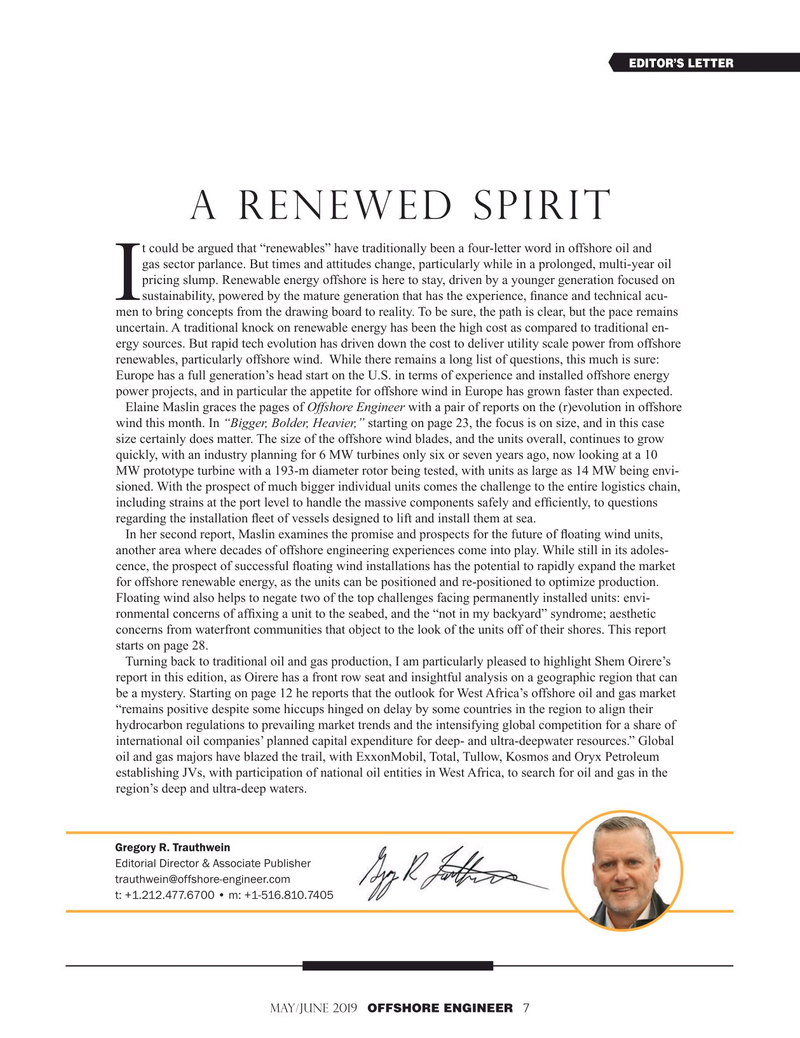
Page 7: of Offshore Engineer Magazine (May/Jun 2019)
Offshore Renewables Review
Read this page in Pdf, Flash or Html5 edition of May/Jun 2019 Offshore Engineer Magazine
EDITOR’S LETTER
A Renewed spirit t could be argued that “renewables” have traditionally been a four-letter word in offshore oil and gas sector parlance. But times and attitudes change, particularly while in a prolonged, multi-year oil pricing slump. Renewable energy offshore is here to stay, driven by a younger generation focused on
Isustainability, powered by the mature generation that has the experience, ? nance and technical acu- men to bring concepts from the drawing board to reality. To be sure, the path is clear, but the pace remains uncertain. A traditional knock on renewable energy has been the high cost as compared to traditional en- ergy sources. But rapid tech evolution has driven down the cost to deliver utility scale power from offshore renewables, particularly offshore wind. While there remains a long list of questions, this much is sure:
Europe has a full generation’s head start on the U.S. in terms of experience and installed offshore energy power projects, and in particular the appetite for offshore wind in Europe has grown faster than expected.
Elaine Maslin graces the pages of Offshore Engineer with a pair of reports on the (r)evolution in offshore wind this month. In “Bigger, Bolder, Heavier,” starting on page 23, the focus is on size, and in this case size certainly does matter. The size of the offshore wind blades, and the units overall, continues to grow quickly, with an industry planning for 6 MW turbines only six or seven years ago, now looking at a 10
MW prototype turbine with a 193-m diameter rotor being tested, with units as large as 14 MW being envi- sioned. With the prospect of much bigger individual units comes the challenge to the entire logistics chain, including strains at the port level to handle the massive components safely and ef? ciently, to questions regarding the installation ? eet of vessels designed to lift and install them at sea.
In her second report, Maslin examines the promise and prospects for the future of ? oating wind units, another area where decades of offshore engineering experiences come into play. While still in its adoles- cence, the prospect of successful ? oating wind installations has the potential to rapidly expand the market for offshore renewable energy, as the units can be positioned and re-positioned to optimize production.
Floating wind also helps to negate two of the top challenges facing permanently installed units: envi- ronmental concerns of af? xing a unit to the seabed, and the “not in my backyard” syndrome; aesthetic concerns from waterfront communities that object to the look of the units off of their shores. This report starts on page 28.
Turning back to traditional oil and gas production, I am particularly pleased to highlight Shem Oirere’s report in this edition, as Oirere has a front row seat and insightful analysis on a geographic region that can be a mystery. Starting on page 12 he reports that the outlook for West Africa’s offshore oil and gas market “remains positive despite some hiccups hinged on delay by some countries in the region to align their hydrocarbon regulations to prevailing market trends and the intensifying global competition for a share of international oil companies’ planned capital expenditure for deep- and ultra-deepwater resources.” Global oil and gas majors have blazed the trail, with ExxonMobil, Total, Tullow, Kosmos and Oryx Petroleum establishing JVs, with participation of national oil entities in West Africa, to search for oil and gas in the region’s deep and ultra-deep waters.
Gregory R. Trauthwein
Editorial Director & Associate Publisher [email protected] t: +1.212.477.6700 • m: +1-516.810.7405
May/June 2019 OFFSHORE ENGINEER 7

 6
6

 8
8